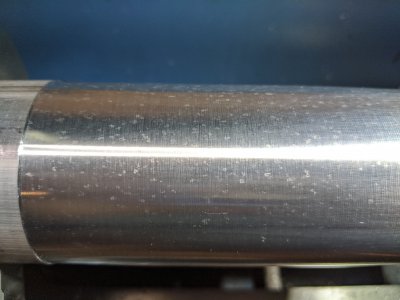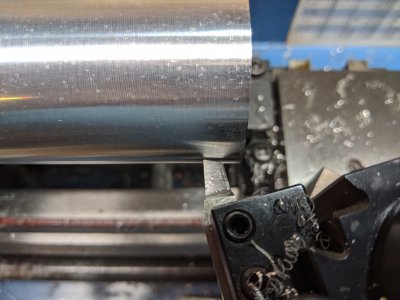- Joined
- Dec 20, 2012
- Messages
- 9,422
The contact point for your headstock IS that front rail. Still, with the machining tolerances of import machines there may be enough play to shift the headstock enough to align it ... maybe. If not, then I would file enough material from the contact point of the headstock where it touches the rail so I can move it. As for vertically shimming the headstock, this is rarely necessary and I would not do it unless there is a major error. The reason for this is that once you do it then aligning the spindle centerline with the tailstock becomes problematic vertically, right? Since there is no provision for aligning the tailstock vertically, I would leave vertical alignment alone.
The reason for suggesting a very short 4" stick out is to limit deflection. Using a long rod will defeat the purpose of this test. 4" is short enough that a sharp properly ground HSS tool will take a 0.001" deep cut with very minimal deflection, thereby giving you a very accurate test. My Emco lathe is aligned this way and a tenths indicator cannot detect any deviation. My Sherline lathe has been aligned like this maybe 50 times or more, probably more, and I can get the headstock aligned to zero deviation using this method.
Over the years, I've tried just about every headstock alignment method I've ever heard of except for using a MT test bar; I don't trust the stacking tolerances part of that method but that is just my personal bias. This test cut method has been the most reliable, repeatable and accurate method for me so I use it. If a test cut made with a good tool using the ways/saddle/tool post of the lathe being tested produces a cut on a rod that shows no deviation over a 4" run, and that rod is heavy enough not to deflect from cutting forces, then the headstock pretty much has to be aligned with the ways, don't you think?
While I'm at all of this, my personal approach to set up is to align the headstock, then level the lathe, then align the tailstock - in that order. If the headstock is off axis then everything else you do will also be off. Think about it.
The reason for suggesting a very short 4" stick out is to limit deflection. Using a long rod will defeat the purpose of this test. 4" is short enough that a sharp properly ground HSS tool will take a 0.001" deep cut with very minimal deflection, thereby giving you a very accurate test. My Emco lathe is aligned this way and a tenths indicator cannot detect any deviation. My Sherline lathe has been aligned like this maybe 50 times or more, probably more, and I can get the headstock aligned to zero deviation using this method.
Over the years, I've tried just about every headstock alignment method I've ever heard of except for using a MT test bar; I don't trust the stacking tolerances part of that method but that is just my personal bias. This test cut method has been the most reliable, repeatable and accurate method for me so I use it. If a test cut made with a good tool using the ways/saddle/tool post of the lathe being tested produces a cut on a rod that shows no deviation over a 4" run, and that rod is heavy enough not to deflect from cutting forces, then the headstock pretty much has to be aligned with the ways, don't you think?
While I'm at all of this, my personal approach to set up is to align the headstock, then level the lathe, then align the tailstock - in that order. If the headstock is off axis then everything else you do will also be off. Think about it.


 in a wooden box?
in a wooden box?
